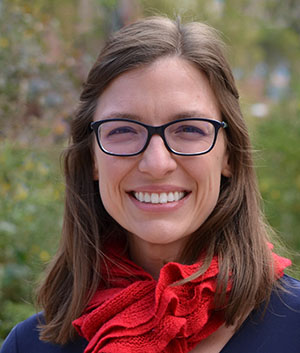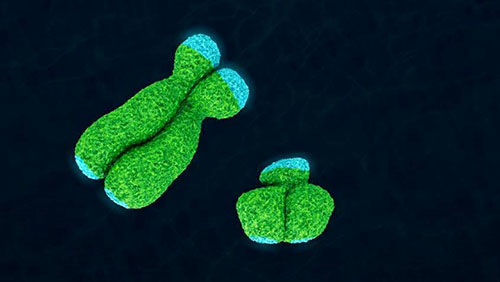2019 NIGMS Director's Early-Career Investigator Lecture
Sex-Biased Genome Evolution
 CREDIT: Jacob Sahertian, ASU.
CREDIT: Jacob Sahertian, ASU.Melissa A. Wilson, Ph.D.
Assistant Professor of Genomics, Evolution and Bioinformatics
Arizona State University
Assistant Professor in the Center for Evolution and Medicine
Biodesign Institute, Arizona State University
Lecture followed by Q&A session
National Institutes of Health
Bethesda, Maryland
Research Summary

If you're merely counting chromosomes, men and women aren't that different. We all have DNA packaged into 23 pairs of chromosomes. Just one of these pairs—the sex chromosomes known as X and Y—is inherited differently in males and females. In general, women have two X chromosomes (XX), and men have one X and one Y chromosome (XY). Today, the human X chromosome is much larger than the human Y chromosome. But that wasn't always the case. Evidence indicates that, in mammals prior to about 200 million years ago, X and Y were the same size and contained the same genes—a perfectly matched pair, essentially indistinguishable from each other, just like the other 22 pairs of chromosomes.
One of the scientists examining how X and Y have changed over time is Melissa Wilson, a computational biologist at Arizona State University. She and her colleagues use high-performance computing, statistics, simulations, and comparative genomics to trace the evolution of sex chromosomes. According to her team's work, the Y chromosome eventually lost much of its DNA. Now, aside from a few relics, the only DNA that X and Y still have in common is at the very tips—the so-called "pseudoautosomal regions."
Wilson and her team are particularly interested in these regions and their relationship with the rest of the X and Y chromosomes. This line of research is important because the differences and similarities in DNA influence whether genes may be swapped between the two members of a chromosome pair.
This swapping, called recombination, allows chromosomes to pair and exchange DNA. It leads to new combinations of genes, creating genetic diversity and enabling evolution. Because X and Y are now so different, the only regions they can swap are the short pseudoautosomal regions.
Wilson is also interested in medical conditions related to sex chromosomes, such as those due to genetic changes on the X or Y chromosome, and those due to an abnormal number of sex chromosomes, such as Klinefelter syndrome (XXY). Her research team also examines why mutation rates differ between males and females, and how changes in population history affect the sex chromosomes differently than the non-sex chromosomes. Her focus is on mammals, but she is also curious about the sex-biased biology of flies, worms, lizards, and plants.
In her NIGMS Director's Early-Career Investigator lecture, Wilson will present an overview of sex differences in disease and summarize the evolutionary history of the human X and Y chromosomes. She will then present new methods to better analyze the genetic blueprint (genome and transcriptome) of the sex chromosomes and explain how that is aiding scientists in understanding sex-linked diseases.
Biographical Sketch
Wilson received her B.S. in Medical Mathematics from Creighton University in Omaha, Nebraska. Her interest in sex chromosomes and their evolution started while, as an NSF graduate research fellow, she worked on her Ph.D. thesis in Integrative Biosciences, Bioinformatics, and Genomics at the Pennsylvania State University. Before joining Arizona State University, Wilson studied as a Miller postdoctoral fellow at the University of California, Berkeley.
Wilson's main research interests at Arizona State University include sex-biased biology. To date, Wilson has published more than 30 scientific articles, reviewed for more than 25 journals, and currently serves as associate editor for three journals. The most recent of her many honors include winning the inaugural Mary Lyon Award from the International Mammalian Genome Society (2019) and receiving the Allan Wilson Junior Award for Independent Research from the Society for Molecular Biology & Evolution (2018).
She also takes time to translate her findings for a general audience. She has written for blogs (for example, pandasthumb.org) and has published her own (mathbionerd.blogspot.com). She teaches in K-12 classrooms and she regularly engages the public in discussions about the difference between sex and gender, the importance (or not) of genetic inheritance, and understanding evolution.
NIGMS funds Wilson's research through an R35 Maximizing Investigators' Research Award.
References:
Wilson Sayres MA. Genetic diversity on the sex chromosomes. Genome Biol. Evol. 2018 10(4):1064-1078. Available from: https://academic.oup.com/gbe/article/10/4/1064/4895090 doi: 10.1093/gbe/evy039
Cotter DJ, Brotman SM, Wilson Sayres MA. Genetic diversity on the human X chromosome does not support a strict pseudoautosomal boundary. Genetics 2016; 203:485-492. Available from: http://www.genetics.org/content/203/1/485 doi: 10.1534/genetics.114.172692.

